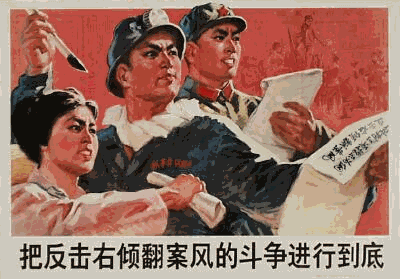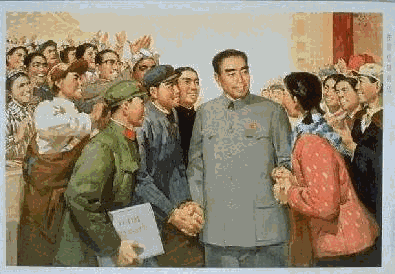
|
|
|
|
|
|
|
|
|
|
|
|
|

Shortly after World War I, on May 4, 1919, patriotic students took to the streets to protest the inequities of the Treaty of Versailles. Despite beatings and many arrests by the government, the enthused students did not quit. Rather, they widened their protest by dispersing their speeches across the city. Even though the May Fourth Incident, as it came to be called, only lasted about a day, it spawned a new movement as all Chinese joined as one in a common cause. Tiananmen Square was the epicenter in the following decades where protestors gravitated to take issue with their concerns and problems. There have been other outbreaks of incidents on June 10, 1925, March 18, 1926, and December 9, 1935. In 1949, Mao Zedong remodeled the entire square and borrowed its power to link it to the great socialist revolution. Party leaders then tried to change the square into a stage for spectacles of obedience and loyalty to the party and Mao. By his death, the square had also become closely aligned with Mao’s great Cultural Revolution.
With the growing political influence of Mao Zedong in the mid 1960s, the time from about 1966 to 1976 has been come to known as the Cultural Revolution Decade. Mao launched the Socialist Education Movement to stop the increasingly capitalistic trends he saw within his political party. The Revolution was used to reform the party and the school system. By 1965, Mao had regained control of the party through the help of Lin Biao. Considerable opposition to the Revolution was evident within the party itself though. Mao and Lin were on one side, supported by the People’s Liberation Army (PLA) while the other side was held by Deng Xiaping, who would come to rise to great power. Prime minister Zhou Enlai was the tie that tried to bind the two factions together. Mao’s side promoted the training of a new generation of revolutionaries, students who became to be known as the Red Guard. This led to massive chaos as the spirited youth clashed with authorities. The PLA was the only group strong enough to restore the country from imminent anarchy. The radicalism began to recede after 1967, when the Deng Xiaping faction had been expelled from political life and Mao was in charge. The militant phase of Revolution ended in April of 1969. Mao’s group seemed to have dominance throughout the Chinese Communist Party (CCP). The general emphasis was placed on reconstruction and rebuilding the party with stabilization, although this was a difficult road. Factional discord continued to exist and would soon give rise again as the era of Mao Zedong came to an end from 1972 to 1976.
After the fall of Lin Biao, Zhou Enlai controlled the party’s political
work. Together, Zhou and Deng exerted great influence. Their
moderate views reformed many of the radical concessions made under Mao,
including liberating persecuted politicians and reforming the economy.
Zhou outlined a program called the Four Modernizations for agriculture,
industry, national defense, and science and technology. In opposition
to the moderatism of Zhou grew the Gang of Four, led by Mao’s wife Qing
Jiang. Zhou was seen as the shining star for the people. However,
his death touched off a movement by the people against the Gang of Four
and the radicalism of the party. Things were not stable in China
and people wanted to restore some sort of socialist democracy. The
current policies of the Cultural Revolution became the focus of a political
struggle that appeared in public during the Tiananmen Incident in 1976.
On the night of April 4, 1976, people laid thousands of wreaths to honor the death of the great leader Zhou Enlai. The Gang of Four was afraid of a movement of the people so they had banned any organization of people at the square. Thousands of people discarded this threat and came anyway on April 5th in a spontaneous demonstration against the radical leaders. Crowds reached more then 100,000, as they were outraged at the removal of the wreaths by the government. Although there was some violence, it was minimal because many of the police were sympathetic with the people.
The incident was labeled counterrevolutionary and blamed on Deng Xiaping by the radical government leaders. On April 7, he was subsequently was removed from office and criticized. This led to a mass campaign against him and led to a wave of arrests of thousands of people who were alleged to be counterrevolutionaries. However, the April 5th Movement would be a powerful political symbol for years to come. It embraced the spirit of popular resistance to an unsatisfactory regime. While the masses showed their support for Zhou (who was Deng’s greatest supporter) and resentment toward the Gang of Four, the government falsely turned it all around onto Deng.
 In the aftermath
of the Tiananmen Incident, the despotism of the Gang of Four grew.
They became more active and proceeded actively to seize more power by criticizing
Deng. In 1976, the political situation deteriorated and many disasters
hit the nation all at once. A massive earthquake hit, killing thousands,
and Mao Zedong passed away also. The Gang of Four was increasingly
trying to gain power by weakening the military and depriving the party
of its power. The CCP could not stand back as the Gang of Four
only pushed the country to chaos. It imprisoned the Gang of Four
and the people were overjoyed. Thus, the end of the Cultural Revolution
came. China was able to take a step toward recovery, but as history
presents it, it was not a smooth ride. As tradition dictated, the
people took to gathering at Tiananmen Square in 1989 when once again students
urged the country towards a democracy movement. It will always stand
as a symbol of democracy and spirit for the people, as a shining star for
the people to turn to in hopes of reform, in the face of adversity.
In the aftermath
of the Tiananmen Incident, the despotism of the Gang of Four grew.
They became more active and proceeded actively to seize more power by criticizing
Deng. In 1976, the political situation deteriorated and many disasters
hit the nation all at once. A massive earthquake hit, killing thousands,
and Mao Zedong passed away also. The Gang of Four was increasingly
trying to gain power by weakening the military and depriving the party
of its power. The CCP could not stand back as the Gang of Four
only pushed the country to chaos. It imprisoned the Gang of Four
and the people were overjoyed. Thus, the end of the Cultural Revolution
came. China was able to take a step toward recovery, but as history
presents it, it was not a smooth ride. As tradition dictated, the
people took to gathering at Tiananmen Square in 1989 when once again students
urged the country towards a democracy movement. It will always stand
as a symbol of democracy and spirit for the people, as a shining star for
the people to turn to in hopes of reform, in the face of adversity.
For most Chinese, Tiananmen Square is a symbol for freedom and justice.
The city itself is called the Gate of Heavenly Peace, quite ironic considering
the amount of political turmoil that has erupted at its feet. The
square is the center of the country’s center, and in this it holds an immense
potency for power, spiritual and political, for the people. Although
Tiananmen Square had been constructed through the hands of Mao Zedong as
a secular shrine for his political party, it quickly turned into much more,
enthralling the people as a sacred place. As the political
waters trembled, especially after the fall of the Qing in 1911, it began
the process of developing from a symbol of authority into an identity of
political dissent. It became a stepping-stone from which the people
could petition the government to redress their hardships and injustices.
Tiananmen Square did not erupt with large-scale public protests until the
1910’s after the last dynasty fell in 1911. At the end of the Cultural
Revolution, the 1976 demonstration was the first impromptu outburst of
mass dissent to erupt since the May Fourth Incident. Although it
was quickly squelched and labeled counterrevolutionary trouble, it was
an eye-opener that the people could still take on the government.
Tiananmen then and now is taken as symbol of democracy for the people.
Binyan, Liu. China's Crisis, China's Hope. Harvard
University Press: Massachusetts, 1990.
Cheng, Chu-Yuan. Behind the Tiananmen Massacre.
Westview Press: Boulder, 1990.
Meisner, Maurice. The Deng Xiaoping Era. Hill and
Wang: New York, 1996.
Miles, James. The Legacy of Tiananmen: China in Disarray.
University of Michigan Press: Ann Arbor, 1996.
Schell, Orville. Mandate of Heaven. Simon and Schuster:
New York, 1994.
http://library.thinkquest.org (historical background)
http://www.chinesechat.org (history of the important people)
http://www.christusrex.org (images)
http://www.iisg.nl/~landsberger
(images and information on people and Cultural
Revolution)